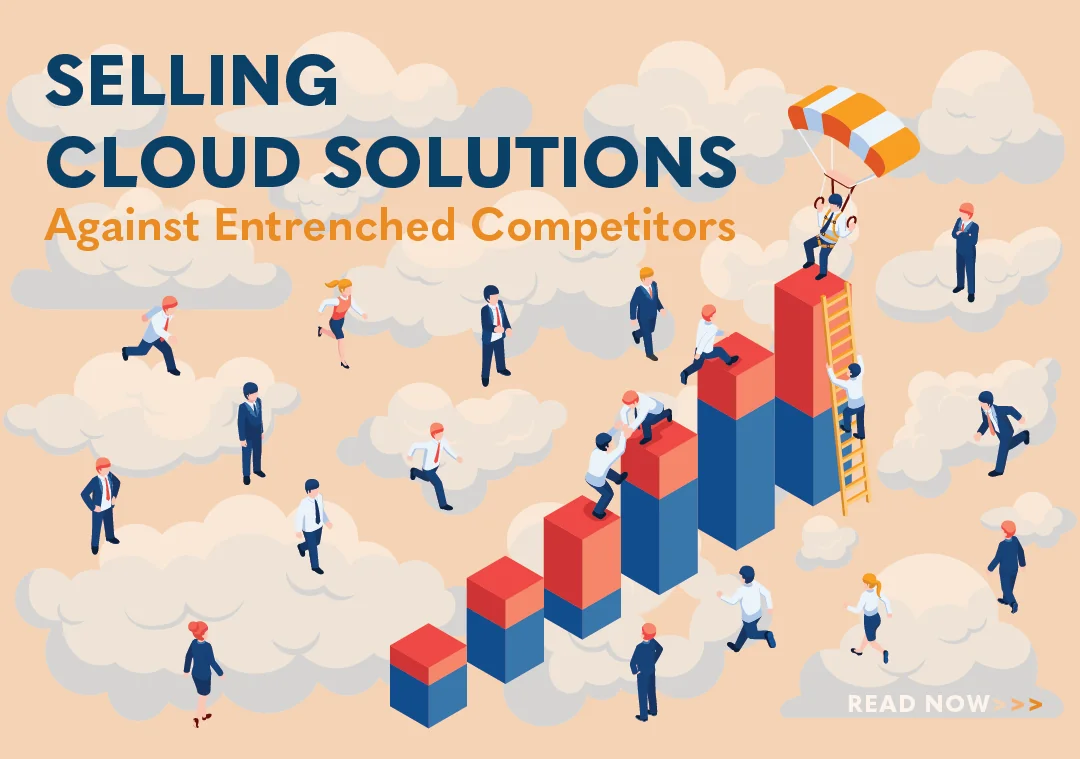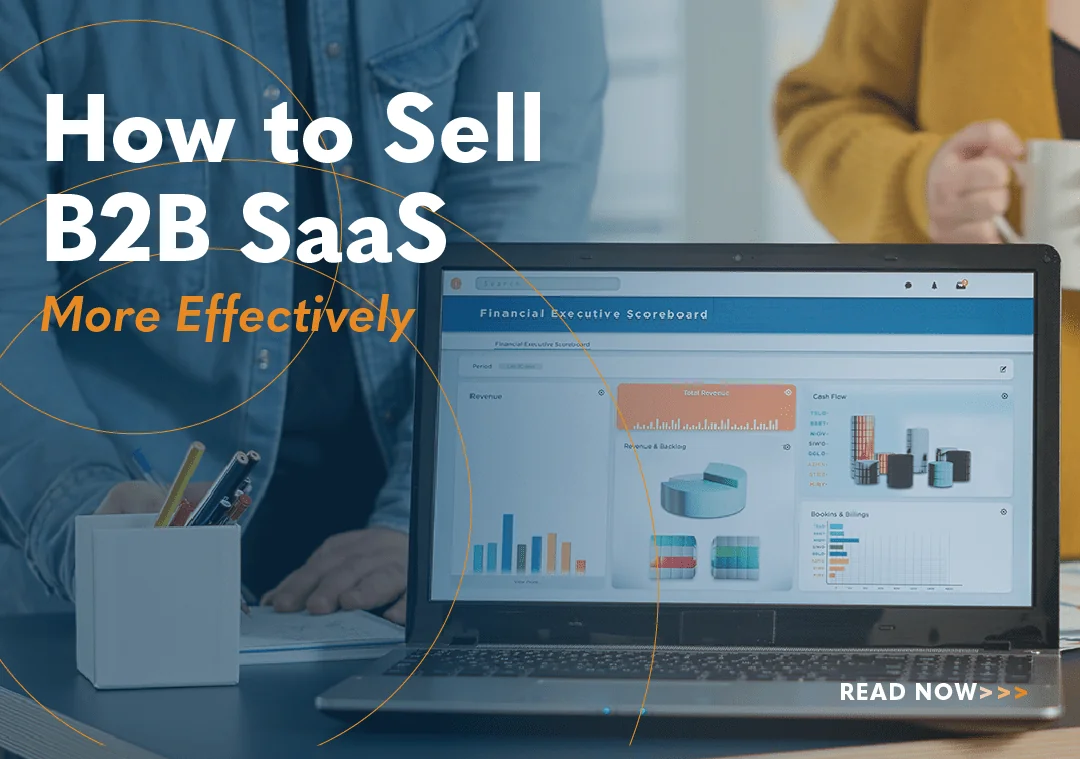Selling Cloud Solutions Against Entrenched Competitors

Every salesperson dreams of selling in a high-demand, low-competition market. Cloud computing is not one of those markets. Demand is high, and so is competition. With an entrenched competitor like Amazon AWS, selling cloud services can feel like swimming against the current. This article explores sales strategies that SaaS sales reps and their organizations can utilize in the highly competitive cloud sales environment.
The Elephant in the Room
AWS is the leader in the cloud market. They were the early adopters, and as they added customers, they added servers and dropped their prices. Lower prices attracted new customers, and the cycle repeated itself. Today, reports indicate AWS controls between 34 – 50 percent of the cloud storage market. This reminds me of the question, “How do you eat an elephant?” One bite at a time.
In my sales career, I’ve never had the advantage of being an elephant. There were always more prominent companies with greater resources who were the entrenched competitors. It always felt like David was selling against Goliath. Being smaller became a strength because it forced me to be creative, nimble, and responsive. Necessity is the mother of invention and being smaller helped me develop my sales skills.
Keep it Positive
Selling in a growing market is exciting. If you sell cloud services, the good news is that the market is expected to double in the next eight years. There are many factors driving demand, and this demand creates new opportunities. Remember, it is easier to grow from a small number of customers than grow from a big number. You might not be able to change the fact that you are not the market leader today, but you can change how you respond.
For example, early in my sales career, I sold communication products. It was around 2000, and the market grew as fast as today’s cloud market. Some companies were absolutely blowing up, and it would have been easy to get distracted or discouraged. We remained focused on our strengths and did not compare ourselves to the companies making the headlines.
Stacking Ws
When going head-to-head against an entrenched competitor, you need to stack your wins to create a compound effect. Stacking Ws creates sales momentum. From CEOs to sales reps, we tend to remember our losses more than our wins. To counterbalance this tendency, finding opportunities for wins creates positive momentum. When we do experience the inevitable loss, it’s not overwhelming.
Stacking Ws does not only have to be winning new business. For me, I’d make it a game starting with what time I woke up, if I hit the gym before work, and what I ate for breakfast. By the time I got to work, I had already stacked four wins. The point is that I knew if I did these little things, the long-term positive impact would be huge.
You unseat a dominant competitor in sales in the same way. The wins will follow when you intensely focus on what you can control. The catchphrase is “Control your controllable.” We cannot control the customer’s decisions, but we can control how many prospecting calls we make, how many follow-up calls we make, and how many hours we invest in our personal development. The key to winning big in sales is stacking the little wins.
Punching Above Your Weight Class
The phrase “Punching above your weight class” is used in boxing to describe a boxer who punches harder than their size. When I think of the entrenched competitor, I think of the flabby boxer who got comfortable being the champion. We might not score a first-round knockout, but we will jab, jab, jab until victory is ours.
In sales, this meant I was consciously and consistently calling on the competitor’s best customers. Jab, jab, jab.
I also knew I needed something better than saying, “I was just checking in,” because that is what average sales reps say when following up with prospects. Planning before each call is critical. Cloud buyers are better informed and expect you to be better informed as well. Effective call planning is a process of using the information you have to shape how you approach the call. What will cloud buyers be interested in? What’s the purpose of the call from their point of view?
Cloud buyers will appreciate information that either informs or makes their life easier. Creating a framework to take your ideas and data and wrap them into a story will help you become more credible. The question I would ask myself is, “What information can I share with a prospect that they would value?”
Often, this can be client wins, where we helped a company improve their business. For example, suppose you recently helped a company transfer a tremendous amount of data from its legacy system to the cloud. Your prospects may be in a similar situation, and your first-hand knowledge can be leveraged.
Moving existing legacy systems to cloud platforms is a complex and time-consuming process. If your company has that experience and technical resources, this could be sought-after information for cloud buyers. At Janek, we call this a trusted advisor rather than a traditional salesperson.
I.T. leaders are drowning in low-value information. When you take the time to call, plan and deliver high-value information, you separate yourself from the field and become a resource rather than a pesky sales rep. In other words, just having cloud solutions is not enough. You must show the prospect that you understand and can provide value to their business.
Avoid Direct Confrontation
Military history shows that a direct confrontation is a mistake when confronted with a superior force. In sales, I knew that if I made it a winner-take-all scenario, my chances of success would be low. That is the game the entrenched competitor wanted to play. But I knew I would win more business through better customer service if I could get my foot in the door.
For example, digital transformation is a broad term, and most CEOs are not fluent in cloud solutions. Anytime there is transformation, there is also tension involved. It does not matter if it’s digital transformation or cloud transformation. Without tension, there will be no transformation. Your company likely has hundreds or thousands of cloud deployments. Can you leverage this expertise to lower your prospect’s tension and provide a roadmap to better business outcomes?
This is not a conversation about server configuration or backup storage. This is a business conversation about how you can help them improve your prospect’s business for the next five to ten years. When prospects see you have the blueprint to improve their business outcomes, you become their trusted advisor.
In Conclusion
The biggest threat for entrenched cloud providers is complacency. Winning makes teams comfortable, cocky, and careless. Against the cloud incumbent, you can win market share with a relentless focus on winning. It starts with stacking Ws–doing the little things necessary for the big wins, like call planning. That is a hard mindset to maintain and why so few have it.
The second step to gaining market share is to figure out what information your prospects will value. There is no shortage of cloud content on Google. As a sales rep selling against a strong competitor, you have to use information as a lens to shift your prospect’s thinking. This means you can’t tell them things they already know. Instead, provide valuable insights and a roadmap to a better future.

- Account Planning (11)
- Awards (50)
- Client Testimonial (37)
- Personal Branding (19)
- Podcast (11)
- Research (68)
- Sales Career Development (85)
- Sales Coaching (154)
- Sales Consulting (133)
- Sales Culture (164)
- Sales Enablement (339)
- Sales Leadership (108)
- Sales Management (240)
- Sales Negotiation (16)
- Sales Prospecting (119)
- Sales Role-Playing (18)
- Sales Training (228)
- Selling Strategies (254)
- Soft Skills (67)
- Talent Management (92)
- Trusted Advisor (27)
- Virtual Selling (41)
- Webinar (10)





























